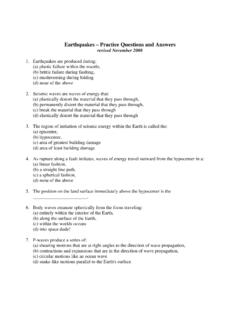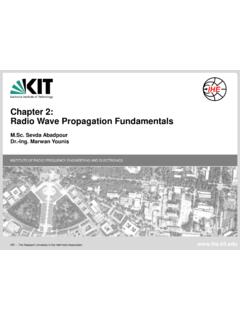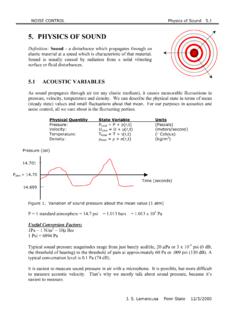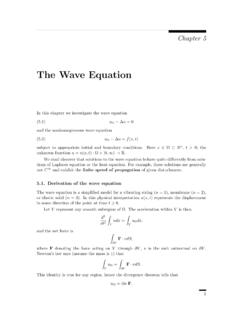Transcription of The Seismic Wave Equation - University of California, San ...
1 Chapter 3. The Seismic Wave Equation Using the stress and strain theory developed in the previous chapter, we now con- struct and solve the Seismic wave Equation for elastic wave propagation in a uniform whole space. We will show that two types of solutions are possible, corresponding to compressional (P ) and shear (S) waves , and we will derive the equations for their velocities that we presented in the last chapter. This will involve vector calculus and complex numbers; some of the mathematics is reviewed in Appendix 2. For simplicity, in this chapter we assume perfect elasticity with no energy loss in the Seismic waves from any intrinsic attenuation. Introduction: The Wave Equation To motivate our discussion, consider the one-dimensional wave Equation 2u 2.
2 2 u = c ( ). t2 x2. and its general solution u(x, t) = f (x ct), ( ). which represents waves of arbitrary shape propagating at velocity c in the positive and negative x directions. This is a very common Equation in physics and can be used to describe, for example, the vibrations of a string or acoustic waves in a pipe. The velocity of the wave is determined by the physical properties of the material through which it propagates. In the case of a vibrating string, c2 = F/ where F is the string tension force and is the density. The wave Equation is classified as a hyperbolic Equation in the theory of linear partial differential equations. Hyperbolic equations are among the most challenging to solve because sharp features in their solutions will persist and can reflect off boundaries.
3 Unlike, for example, the diffusion Equation , solutions will be smooth only if the initial conditions are smooth. This complicates both analytical and numerical solution methods. As we will see, the Seismic wave Equation is more complicated than Equation ( ) because it is three dimensional and the link between force and displacement 37. 38 CHAPTER 3. THE Seismic WAVE Equation . x3 t(-x1) dx3. x2. t(x1). x1 dx2. dx1. Figure : The force on the (x2 , x3 ) face of an infinitesimal cube is given by t(x 1 ) dx2 dx3 , the product of the traction vector and the surface area. involves the full stress-strain relationship for an elastic solid. However, the P and S. Seismic wave solutions share many characteristics with the solutions to the 1-D wave Equation . They involve pulses of arbitrary shape that travel at speeds determined by the elastic properties and density of the medium, and these pulses are often decomposed into harmonic wave solutions involving sine and cosine functions.
4 Stein and Wysession (2003, section ) provide a useful review of the 1-D wave Equation as applied to a vibrating string, with analogies to Seismic wave propagation in the Earth. The Momentum Equation In the previous chapter, the stress, strain, and displacement fields were considered in static equilibrium and unchanging with time. However, because Seismic waves are time-dependent phenomena that involve velocities and accelerations, we need to account for the effect of momentum. We do this by applying Newton's law (F = ma from your freshman physics class) to a continuous medium. Consider the forces on an infinitesimal cube in a (x1 , x2 , x3 ) coordinate system (Figure ). The forces on each surface of the cube are given by the product of the traction vector and the surface area.
5 For example, the force on the plane normal to x1 is given by F(x 1 ) = t(x 1 ) dx2 dx3. = x 1 dx2 dx3. 11.. = 21 dx2 dx3 , ( ). 31. where F is the force vector, t is the traction vector, and is the stress tensor. In the case of a homogeneous stress field, there is no net force on the cube since the forces on opposing sides will cancel out, that is, F( x 1 ) = F(x 1 ). Net force will only be exerted on the cube if spatial gradients are present in the stress field. In this case, the net force from the planes normal to x1 is .. 11 . F(x 1 ) = 21 dx1 dx2 dx3 , ( ). x1. 31. THE MOMENTUM Equation 39. and we can use index notation and the summation convention to express the total force from the stress field on all the faces of the cube as 3. X ij Fi = dx1 dx2 dx3. j=1.
6 Xj = j ij dx1 dx2 dx3 . ( ). The dj ij term is the divergence of the stress tensor (recall that summation conven- tion means that this term is summed over j = 1, 2, 3). There may also exist a body force on the cube that acts in proportion to the volume of material, that is, Fibody = fi dx1 dx2 dx3 . ( ). The mass of our infinitesimal cube is given by m = dx1 dx2 dx3 , ( ). where is the density. The acceleration of the cube is given by the second time derivative of the displacement u. Substituting ( ) ( ) into F = ma and canceling the common factor of dx1 dx2 dx3 , we obtain1. 2 ui = j ij + fi . ( ). t2. This is the fundamental Equation that underlies much of seismology. It is called the momentum Equation or the Equation of motion for a continuum. Each of the terms, ui , ij and fi is a function of position x and time.
7 The body force term f generally consists of a gravity term fg and a source term fs . Gravity is an important factor at very low frequencies in normal mode seismology, but it can generally be neglected for body- and surface-wave calculations at typically observed wavelengths. We will consider the effects of the source term fs later in this book (Chapter 9). In the absence of body forces, we have the homogeneous Equation of motion 2 ui = j ij , ( ). t2. which governs Seismic wave propagation outside of Seismic source regions. Gener- ating solutions to ( ) or ( ) for realistic Earth models is an important part of seismology; such solutions provide the predicted ground motion at specific locations at some distance from the source and are commonly termed synthetic seismograms.
8 If, on the other hand, we assume that the acceleration term in ( ) is zero, the result is the static equilibrium Equation j ij = fi . ( ). 1. In expressing the acceleration term, we approximate the total derivatives of u with respect to time with the partial derivatives of u with respect to time. That is, we make the small-deformation approximation such that the terms in the total derivative containing the spatial derivatives of u can be ignored. This is generally assumed valid in seismology, but the spatial derivatives (advection terms) are very important in fluid mechanics. 40 CHAPTER 3. THE Seismic WAVE Equation . in which the body forces are balanced by the divergence of the stress tensor. This Equation is applicable to static deformation problems in geodesy, engineering and many other fields.
9 The Seismic Wave Equation In order to solve ( ) we require a relationship between stress and strain so that we can express in terms of the displacement u. Recall the linear, isotropic stress . strain relationship, ij = ij ekk + 2 eij , ( ). where and are the Lame parameters and the strain tensor is defined as eij = 21 ( i uj + j ui ). ( ). Substituting for eij in ( ), we obtain ij = ij k uk + ( i uj + j ui ). ( ). Equations ( ) and ( ) provide a coupled set of equations for the displacement and stress. These equations are sometimes used directly at this point to model wave propagation in computer calculations by applying finite-difference techniques. In these methods, the stresses and displacements are computed at a series of grid points in the model, and the spatial and temporal derivatives are approximated through numerical differencing.
10 The great advantage of finite-difference schemes is their relative simplicity and ability to handle Earth models of arbitrary complex- ity. However, they are extremely computationally intensive and do not necessarily provide physical insight regarding the behavior of the different wave types. In the equations that follow, we will switch back and forth between vector nota- tion and index notation. A brief review of vector calculus is given in Appendix B. If we substitute ( ) into ( ), we obtain 2 ui = j [ ij k uk + ( i uj + j ui )]. t2. = i k uk + i k uk + j ( i uj + j ui ) + j i uj + j j ui = i k uk + j ( i uj + j ui ) + i k uk + i j uj + j j ui . ( ). Defining u = 2 u/ t2 , we can write this in vector notation as u = ( u) + [ u + ( u)T ] + ( + ) u + 2 u. ( ).










